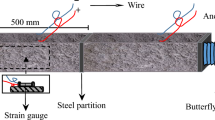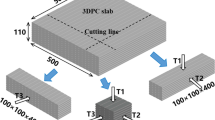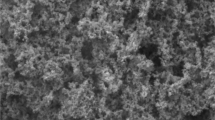Abstract
In order to explore the strength, water stability, compressibility, shear properties of cement stabilized silt, the one-dimensional consolidation tests, direct shear and unconfined compression tests were conducted on cement solidified silt. In addition, the microscopic characteristics of cement stabilized silt were investigated by using scanning electron microscope (SEM) and X-ray diffraction (XRD) tests. The unconfined compression tests showed that the unconfined compressive strength (UCS) raised with cement dosage increasing, and first increased rapidly and then raised slowly with the prolongation of curing time. As curing time prolonged, the water stability coefficient (K>r) of 2% cement stabilized silt raised significantly, while the Kr of 4% and 6% cement stabilized silt almost hardly changed. As cement dosage increased, at 7 days of curing age, the compressive modulus of cement stabilized silt raised. However, at 28 and 90 days of curing, the compressive modulus first raised and then reduced. As curing time increased, the compressive modulus increased at first and then deceased slightly. The direct shear tests demonstrated that the internal friction angle of cement solidified silt was almost unchanged with increasing cement dosage, but the internal friction angle increased slightly with the prolongation of curing time. For 2% and 4% cement stabilized silt, the cohesion raised with the prolongation of curing time. Meanwhile, the cohesion of 6% cement solidified silt at 7 days was slightly larger that of 28 days. Besides, the SEM and XRD analysis indicated that the loose structure of silt was improved due to cement addition.
Similar content being viewed by others
Abbreviations
- c :
-
Cohesion
- E s :
-
Compressive modulus
- K r :
-
Water stability coefficient
- q u :
-
Unconfined compression strength of specimen under standard curing condition
- q u :
-
Unconfined compression strength of specimen cured in water
- UCS:
-
Unconfined compression strength
- α :
-
Compressibility coefficient
- ϕ :
-
Internal friction angle
References
Al-Rawas AA, Hago AW, Al-Sarmi H (2005a) Effect of lime, cement and Sarooj (artificial pozzolan) on the swelling potential of an expansive soil from Oman. Building and Environment 40:681–687, DOI: https://doi.org/10.1016/j.buildenv.2004.08.028
Al-Rawas A, Hassan HF, Taha R, Hago A, Al-Shandoudi B, Al-Suleimani Y (2005b) Stabilization of oil-contaminated soils using cement and cement by-pass dust. Management of Environmental Quality An International Journal 16(6):670–680, DOI: https://doi.org/10.1108/14777830510623736
Anagnostopoulos, Costas A (2015) Strength properties of an epoxy resin and cement-stabilized silty clay soil. Applied Clay Science 114:517–529, DOI: https://doi.org/10.1016/j.clay.2015.07.007
ASTM D422-63 (2007) Standard test method for particle-size analysis of soils. ASTM D422-63, ASTM International, West Conshohocken, PA, USA
ASTM D698-12 (2012) Standard test methods for laboratory compaction of soil standard effort. ASTM D698-12, ASTM International, West Conshohocken, PA, USA
ASTM D854-10 (2010) Standard methods for specific gravity of soils by water pycnometer. ASTM D854-10, ASTM International, West Conshohocken, PA, USA
ASTM D2435/D2435M-11 (2011) Standard test methods for one dimensional consolidation properties of soils using incremental loading. ASTM D2435/D2435M-11, ASTM International, West Conshohocken, PA, USA
ASTM D2487 (2011) Standard practice for classification of soils for engineering purposes (unified soil classification system). ASTM D2487, ASTM International, West Conshohocken, PA, USA
ASTM D3080/D3080M-11 (2011) Standard test method for direct shear test of soils under consolidated drained conditions. ASTM D3080/D3080M-11, ASTM International, West Conshohocken, PA, USA
ASTM D4219-08 (2008) Standard test method for unconfined compressive strength index of chemical-grouted soils. ASTM D4219-08, ASTM International, West Conshohocken, PA, USA
ASTM D4318-10 (2010) Standard test methods for liquid limit, plastic limit and plasticity index of soils. ASTM D4318-10, ASTM International, West Conshohocken, PA, USA
Bahar R, Benazzoug M, Kenai S (2004) Performance of compacted cement-stabilised soil. Cement and Concrete Composites 26(7):811–820, DOI: https://doi.org/10.1016/j.cemconcomp.2004.01.003
Cai GJ, Zhang T, Liu SY, Li JH, Jie DB (2016) Stabilization mechanism and effect evaluation of stabilized silt with lignin based on laboratory data. Marine Georesources & Geotechnology 34(4):331–340, DOI: https://doi.org/10.1080/1064119X.2014.966217
Cengiz S, Cakir I, Sevindik A (2002) SEM-EDS in rapid prediction of death place of drown-died green sea turtle by comparison of lung bronchial surface and sea water composition (results of a rapid assessment). Trace Elements in Medicine 19:70–74
Cengiz S, Karaca AC, çakır I, Öner HB, Sevindik A (2004) SEM-EDS analysis and discrimination of forensic soil. Forensic Science International 141:33–37, DOI: https://doi.org/10.1016/j.forsciint.2003.12.006
Chew SH, Kamruzzaman AHM, Lee FH (2004) Physicochemical and engineering behavior of cement treated clays. Journal of Geotechnical and Geoenvironmental Engineering 130:696–706, DOI: https://doi.org/10.1061/(ASCE)1090-0241(2004)130:7(696)
Du YJ, Jiang NJ, Liu SY, Jin F, Singh DN, Puppala AJ (2014) Engineering properties and microstructural characteristics of cement-stabilized zinc-contaminated kaolin. Canadian Geotechnical Journal 51:289–302, DOI: https://doi.org/10.1139/cgj-2013-0177
Du YJ, Jiang NJ, Shen SL, Jin F (2013a) Experimental investigation of influence of acid rain on leaching and hydraulic characteristics of cement-based solidified/stabilized lead contaminated clay. Journal of Hazardous Materials 225–226(10):195–201, DOI: https://doi.org/10.1016/j.jhazmat.2012.04.072
Du YJ, Wei ML, Jin F, Liu ZB (2013b) Stress-strain relation and strength characteristics of cement treated zinc-contaminated clay. Engineering Geology 167(12):20–26, DOI: https://doi.org/10.1016/j.enggeo.2013.10.005
Falciglia PP, Romano S, Fga V (2017) Application of a γRS index-based method and techno-economic analysis for in situ treatment of Cs-contaminated soils by cement-barite based stabilisation/solidification. Journal of Environmental Management 197:619–630, DOI: https://doi.org/10.1016/j.jenvman.2017.04.037
Goodarzi AR, Akbari HR, Salimi M (2016) Enhanced stabilization of highly expansive clays by mixing cement and silica fume. Applied Clay Science 132–133:675–684, DOI: https://doi.org/10.1016/j.clay.2016.08.023
Hilmi Lav A, Aysen Lav M, Burak Goktepe A (2006) Analysis and design of a stabilized fly ash as pavement base material. Fuel 85(16):2359–2370, DOI: https://doi.org/10.1016/j.fuel.2006.05.017
Ho MH, Chan CM (2011) Some mechanical properties of cement stabilized Malaysian soft clay. Word Academy of Science, Engineering and Technology 50:24–31
Horpibulsk S, Rachan R, Suddeepong A, Chinkulkijniwat A (2011) Strength development in cement admixed Bangkok clay: Laboratory and field investigations. Soils and Foundations 51:239–251, DOI: https://doi.org/10.3208/sandf.51.239
Hossain K, Lachemi M, Easa S (2007) Stabilized soils for construction applications incorporating natural resources of Papua new Guinea. Resources, Conservation & Recycling 51(4):711–731, DOI: https://doi.org/10.1016/j.resconrec.2006.12.003
Jauberthie R, Rendell F, Rangeard D, Molez L (2010) Stabilisation of estuarine silt with lime and/or cement. Applied Clay Science 50(3): 0–400, DOI: https://doi.org/10.1016/j.clay.2010.09.004
Kamruzzaman A, Chew S, Lee F (2009) Structuration and destructuration behavior of cement-treated Singapore marine clay. Journal of Geotechnical and Geoenvironmental Engineering 135:573–589, DOI: https://doi.org/10.1061/(ASCE)1090-0241(2009)135:4(573)
Kariyawasam K, Jayasinghe C (2016) Cement stabilized rammed earth as a sustainable construction material. Construction and Building Materials 105:519–527, DOI: https://doi.org/10.1016/j.conbuildmat.2015.12.189
Kogbara RB, Altabbaa A (2011) Mechanical and leaching behaviour of slag-cement and lime-activated slag stabilised/solidified contaminated soil. Science of the Total Environment 409(11):2325–2335, DOI: https://doi.org/10.1016/j.scitotenv.2011.02.037
Lee S, Chang I, Chung MK, Kim Y, Kee J (2017) Geotechnical shear behavior of Xanthan Gum biopolymer treated sand from direct shear testing. Geomechanics and Engineering 12(5):831–847, DOI: https://doi.org/10.12989/gae.2017.12.5.831
Li J (2010) Properties of silt embankment in anhui province. MSc Thesis, Tianjin University, Tianjin, China
Li J, Xue Q, Wang P, Zhang T (2016) Comparison of solidification/stabilization of lead contaminated soil between magnesia-phosphate cement and ordinary portland cement under the same dosage. Environmental Progress & Sustainable Energy 35(1):88–94, DOI: https://doi.org/10.1002/ep.12204
Liu J, Xiao J (2009) Experimental study on the stability of railroad silt subgrade with increasing train speed. Journal of Geotechnical and Geoenvironmental Engineering 136(6):833–841, DOI: https://doi.org/10.1061/(ASCE)GT.1943-5606.0000282
Liu L, Zhou A, Deng YF, Cui YJ, Yu Z, Yu C (2019) Strength performance of cemen1/slag-based stabilized soft clays. Construction and Building Materials 211:909–918, DOI: https://doi.org/10.1016/j.conbuildmat.2019.03.256
Lu X, Cui M, Wang P, Li B (2018) Application in cement soil of stabilizer in silt soft soil of Wuxi in China. Journal of Coastal Research, Special Issue 83:316–323, DOI: https://doi.org/10.2112/SI83-052.1
Ma C, Chen L, Chen B (2014) Analysis of strength development in soft clay stabilized with cement-based stabilizer. Construction and Building Materials 71:354–362, DOI: https://doi.org/10.1016/j.conbuildmat.2014.08.087
MCPRC (2007) Test methods of soils for highway engineering. Ministry of Communications of the People’s Republic of China, China Communication Pressing, Beijing, China
MCPRC (2009) Test methods materials stabilized with inorganic binder materials for highway engineering. Ministry of Communications of the People’s Republic of China, China Communication Pressing, Beijing, China
Mitchell JK, Soga K (2005) Fundamentals of soil behavior, 3rd edition. John Wiley & Sons, Hoboken, NJ, USA
Muhwezi L, Achanit SE (2019) Effect of sand on the properties of compressed soil-cement stabilized blocks. Colloid and Surface Science 4(1):1–6, DOI: https://doi.org/10.11648/j.css.20190401.11
Ollila HJ, Moilanen A, Tiainen MS, Laitinen RS (2006) SEM-EDS characterization of inorganic material in refuse-derived fuels. Fuel 85:2586–2592, DOI: https://doi.org/10.1016/j.fuel.2006.05.018
Pariatamby A, Subramaniam C, Mizutani S, Takatsuki H (2016) Solidification and stabilization of fly ash from mixed hazardous waste incinerator using ordinary Portland cement. Environmental Sciences An International Journal of Environmental Physiology & Toxicology 13(5):289–96
Prusinski J, Bhattacharja S (1999) Effectiveness of portland cement and lime in stabilizing clay soils. Transportation Research Record 1652:215–227
Pu SY, Zhu ZD, Song WL, Wan Y, Wang HR, Xu XY (2020) Comparative study of compressibility and deformation properties of silt stabilized with lime, lime, and cement, and SEU-2 binder. Arabian Journal for Science and Engineering 45:4125–4139, DOI: https://doi.org/10.1007/s13369-020-04406-9
Pu SY, Zhu ZD, Song WL, Wang HR, Wei RJ (2019a) Deformation properties of silt solidifified with a new SEU-2 binder. Construction and Building Materials 220:267–277, DOI: https://doi.org/10.1016/j.conbuildmat.2019.06.016
Pu SY, Zhu ZD, Wang HR, Song WL, Wei RJ (2019b) Mechanical characteristics and water stability of silt solidified by incorporating lime, lime and cement mixture, and SEU-2 binder. Construction and Building Materials 214:111–120, DOI: https://doi.org/10.1016/j.conbuildmat.2019.04.103
Rao SN, Rajasekaran G (1996) Reaction products formed in lime-stabilized marine clays. Journal of Geotechnical Engineering 122(5):329–336
Saride S, Puppala AJ, Chikyala SR (2013) Swell-shrink and strength behaviors of lime and cement stabilized expansive organic clays. Applied Clay Science 85:39–45, DOI: https://doi.org/10.1016/j.clay.2013.09.008
Sariosseiri F, Muhunthan B (2009) Effect of cement treatment on geotechnical properties of some Washington state soils. Engineering Geology 104(1–2):119–125, DOI: https://doi.org/10.1016/j.enggeo.2008.09.003
Stegemann JA, Zhou Q (2009) Screening tests for assessing treatability of inorganic industrial wastes by stabilisation/solidification with cement. Journal of Hazardous Materials 161(1):300–306, DOI: https://doi.org/10.1016/j.jhazmat.2008.03.090
Voglar GE, Leštan D (2010) Solidification/stabilisation of metals contaminated industrial soil from former Zn smelter in Celje, Slovenia, using cement as a hydraulic binder. Journal of Hazardous Materials 178(1):926–933, DOI: https://doi.org/10.1016/j.jhazmat.2010.02.026
Voglar GE, Leštan D (2011) Efficiency modeling of solidification/stabilization of multi-metal contaminated industrial soil using cement and additives. Journal of Hazardous Materials 192(2):753–762, DOI: https://doi.org/10.1016/j.jhazmat.2011.05.089
Wang DX, Abriak NE, Zentar R, Xu WY (2012) Solidification/stabilization of dredged marine sediments for road construction. Environmental Technology 33(1):95–101, DOI: https://doi.org/10.1080/09593330.2011.551840
Wang L, Cho DW, Tsang DCW, Cao X, Hou D, Shen Z, Alessi DS, Ok YS, Poon CS (2019) Green remediation of as and Pb contaminated soil using cement-free clay-based stabilization/solidification. Environment International 126:336–345, DOI: https://doi.org/10.1016/j.envint.2019.02.057
Wang YS, Dai JG, Wang L, Tsang DCW, Poon CS (2017) Influence of lead on stabilization/solidification by ordinary portland cement and magnesium phosphate cement. Chemosphere 190:90–96, DOI: https://doi.org/10.1016/j.chemosphere.2017.09.114
Wang JJ, Guo JJ, Bai JP, Wu X (2018a) Shear strength of sandstone-mudstone particle mixture from direct shear test. Environmental Earth Sciences 77(12):442
Wang F, Wang H, Altabbaa A (2015) Time-dependent performance of soil mix technology stabilized/solidified contaminated site soils. Journal of Hazardous Materials 286:503–508, DOI: https://doi.org/10.1016/j.jhazmat.2015.01.007
Wang DX, Zentar R, Abriak NE (2018b) Durability and swelling of solidified/stabilized dredged marine soils with class-F fly ash, cement, and lime. Journal of Materials in Civil Engineering 30(3):04018013, DOI: https://doi.org/10.1061/(ASCE)MT.1943-5533.0002187
Xi Y, Wu X, Hao X (2014) Solidification/stabilization of Pb-contaminated soils with cement and other additives. Journal of Soil Contamination 23(8):887–898, DOI: https://doi.org/10.1080/15320383.2014.890168
Xiao JH, Juang CH, Xu CJ, Li XW, Wang L (2014) Strength and deformation characteristics of compacted silt from the lower reaches of the Yellow River of China under monotonic and repeated loading. Engineering Geology 178:49–57, DOI: https://doi.org/10.1016/j.enggeo.2014.06.008
Xiao WH, Lee HF (2008) Curing time effect on behavior of cement treated marine clay. International Journal of Engineering and Applied Sciences 5:427–434
Xu S, Wu X, Cai Y, Ding Y, Wang Z (2018) Strength and leaching characteristics of magnesium phosphate cement-solidified zinc-contaminated soil under the effect of acid rain. Soil and Sediment Contamination 27(2):1–14
Yin CY, Shaaban MG, Mahmud HB (2007) Chemical stabilization of scrap metal yard contaminated soil using ordinary portland cement: Strength and leachability aspects. Building and Environment 42(2):794–802, DOI: https://doi.org/10.1016/j.buildenv.2005.09.013
Yong RN, Ouhadi VR (2007) Experimental study on instability of bases on natural and lime/cement-stabilized clayey soils. Applied Clay Science 35(3–4):0–249, DOI: https://doi.org/10.1016/j.clay.2006.08.009
Zhao H, Zhou K, Zhao C, Gong BW, Liu J (2016) A long-term investigation on microstructure of cement-stabilized handan clay. Revue Française de Génie Civil 20(2):16, DOI: https://doi.org/10.1080/19648189.2015.1030087
Zhu ZD (2006) Study on stabilization of silt subgrade: Theory and application. PhD Thesis, Southeast University, Nanjing, China
Zhu ZD, Liu SY (2008) Utilization of a new soil stabilizer for silt subgrade. Engineering Geology 97(3–4):192–198, DOI: https://doi.org/10.1016/j.enggeo.2008.01.003
Acknowledgements
The authors express their thanks to the KSCE Journal of Civil Engineering reviewers and editors for their instructive suggestions.
Author information
Authors and Affiliations
Corresponding author
Rights and permissions
About this article
Cite this article
Pu, S., Zhu, Z., Song, W. et al. Mechanical and Microscopic Properties of Cement Stabilized Silt. KSCE J Civ Eng 24, 2333–2344 (2020). https://doi.org/10.1007/s12205-020-1671-0
Received:
Revised:
Accepted:
Published:
Issue Date:
DOI: https://doi.org/10.1007/s12205-020-1671-0




